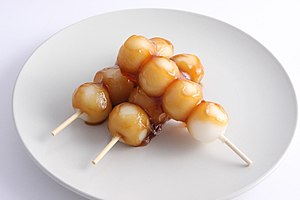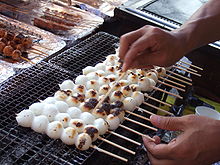Dango
 Mitarashi dango Mitarashi dango | |
| Type | Sweets, Dumpling |
|---|---|
| Place of origin | Japan |
| Main ingredients | Rice flour |
 Yaki dango being prepared
Yaki dango being prepared
Dango (団子) is a Japanese dumpling made from rice flour mixed with uruchi rice flour and glutinous rice flour. It is different from the method of making mochi, which is made after steaming glutinous rice. Dango is usually finished round shaped, three to five dango are often served on a skewer (skewered dango pieces called kushi-dango (串団子)). Generally, dango comes under the category of wagashi, and is often served with green tea. It is eaten year-round, but the different varieties are traditionally eaten in given seasons.
Types
The many different varieties of dango are usually named after the various seasonings served on or with it.
Popular dango
- Anko dango (あんこ団子) is commonly covered with sweetened red bean paste; ingredients other than azuki are used on rare occasions. Other toppings for anko include zunda (ずんだ) made from edamame paste and kurumi (walnut) paste.
- Cha dango (茶団子) is green tea (matcha) flavored dango.
- Shoyu dango (醤油だんご) is a kind of baked dango (yaki dango (焼き団子)) and is seasoned with soy sauce. Furthermore, the one wrapped with nori is called isobe dango (磯辺団子).
- Hanami dango (花見だんご) also known as sanshoku dango (三色団子) is eaten during hanami. It has three colors (pink, white and green), and is traditionally made during sakura-viewing season, hence the name (hanami means "flower viewing"; hana meaning "flower", and mi meaning "to see"). The order of the three colored dumplings is said to represent the order in which cherry blossoms bloom. Pink represents cherry buds, white represents cherry blossoms in full bloom, and green represents leafy cherry blossoms after they have fallen.
- Kibi dango (きび団子) is made with millet flour. This variety is prominently featured in the tale of Momotarō, a folkloric Japanese hero, who offers the rounded ball (not skewered) to three talking animals in exchange for their aid in fighting demons.
- Kinako dango (きなこ団子) is made with toasted soy flour.
- Kusa dango or yomogi dango (草団子 or よもぎ団子) is mixed leaves of yomogi, like kusa mochi. It is often covered with anko.
- Mitarashi (みたらし団子) is covered with a syrup made from shouyu (soy sauce), sugar, and starch.
- Sasa dango (笹団子) is produced and eaten primarily in Niigata Prefecture. Sasa dango has two varieties: onna dango and otoko dango. Onna dango (literally "female dango") is filled with anko, while the otoko dango (literally "male dango") is filled with kinpira. The dango is wrapped in leaves of sasa for the purpose of preservation.
- Shiratama dango (白玉だんご) is eaten in anmitsu or mitsumame.
- Tsukimi dango (月見だんご) is white dango to eat during Tsukimi. It is traditionally made during autumn full moon (Mid-Autumn Festival).
Various other dango
- Botchan dango (坊っちゃん団子) has three colors. One is colored by red beans, the second by eggs, and the third by green tea. Botchan dango is a product name of Ehime’s miyagegashi, which was named after Natsume Sōseki’s novel Botchan.
- Chichi dango (乳団子) is a slightly sweet, light treat usually eaten as a dessert.
- Denpun dango (でんぷん団子) from Hokkaido is made from potato flour and baked with sweet boiled beans.
- Kuri dango (栗だんご) is coated in chestnut paste.
- Niku dango (肉団子) is a type of Japanese meatball. Chicken niku dango is called tsukune, served on a skewer.
Derived terms
A common Japanese proverb "hana yori dango" (花より団子, literally, "dango rather than flowers") refers to a preference for practical things rather than aesthetics.
A hairstyle consisting of dango-like buns on either side of the head is sometimes known as odango.
Dorodango is a Japanese art form in which earth and water are molded to create a delicate, shiny sphere, resembling a billiard ball.
In Vietnam
Bánh hòn is a specialty dessert of Phan Thiet. The cake is made from tapioca flour, coconut, roasted peanuts, salt and sugar. When finished, it is rolled over shredded coconut and skewered like Japanese dango.
Unicode character
The Unicode emoji character 🍡 is used to resemble hanami dango. The character was introduced in October 2010.
See also
References
- ^ 大辞林 第三版「だんご〔団子〕」- コトバンク 2020年4月3日閲覧
- ^ Rachel (April 14, 2008). "Dango Digest: A Thorough Look at Japanese Dumplings, Part Two". theanimeblog.com. Archived from the original on 2008-09-15.
- ^ "Wagashi: Chadango and Minazuki". June 29, 2008. Retrieved 2009-03-28.
- ^ "Niku Dango - Sumo Kitchen". Sumokitchen.com. Retrieved 21 December 2017.
- ^ "Unicode Character 'DANGO' (U+1F361)". Fileformat.info. Retrieved 2017-03-02.
| Japanese food and drink | |
|---|---|
| Main dishes |
|
| Side dishes | |
| Beverages | |
| Snacks / desserts | |
| Ingredients / condiments | |
| Utensils | |
| Lists | |
| Fruits | |
| Related | |